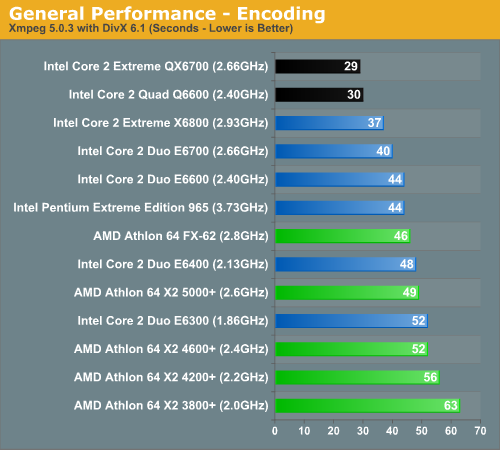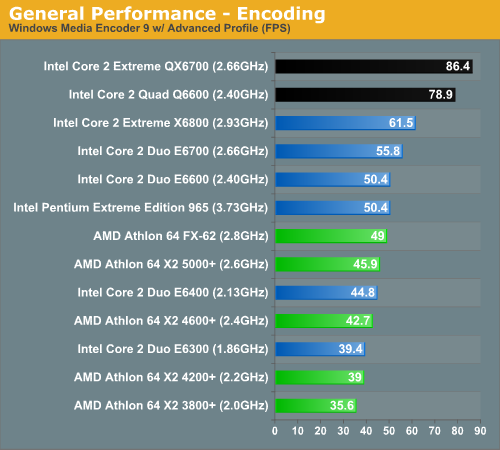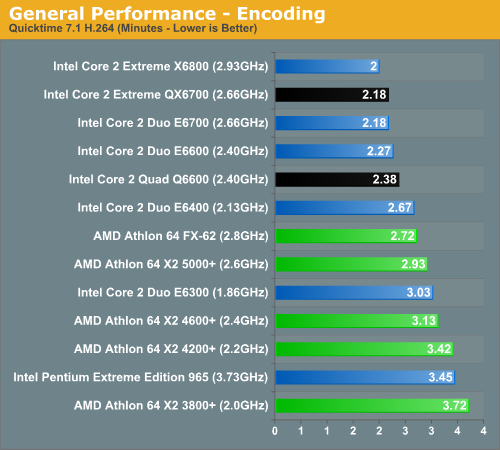Intel's Core 2 Extreme QX6700: The Multi-core Era Begins
by Anand Lal Shimpi on November 2, 2006 2:14 AM EST- Posted in
- CPUs
Encoding Performance using DivX 6.1, WME9, Quicktime (H.264) & iTunes
Although to a lesser degree than 3D rendering applications, encoding apps benefit very well from moving to more cores. DivX and Windows Media Encoder show a ~40%-55% improvement while QuickTime's H.264 encoding shows basically no benefit, and neither does MP3 encoding. There is certainly potential for either task to be further optimized for multi-core architectures, and hopefully we will see that in future versions of the software, but without proper programming support, even tasks that could potentially make great use of quad core processors will show little to no benefit.




3D Rendering Performance using 3dsmax 7 & CineBench 9.5
Gaming Performance using Quake 4, Battlefield 2 & Half Life 2 Episode 1










59 Comments
View All Comments
archcommus - Thursday, November 2, 2006 - link
Quote form the conclusion page:"We don't expect dual or quad core to be necessary for gaming anytime in the next 9 months..."
Really? That is surprising to hear. 9 months takes us to next July. I thought Alan Wake would definitely be released before then, and I thought that game REQUIRED two cores and would greatly benefit from four. Are you sure that statement isn't supposed to read "We don't expect QUAD CORE to be necessary for gaming anytime in the next 9 months..."?
JarredWalton - Thursday, November 2, 2006 - link
I thought Alan Wake was looking more like late 2007 (along with Unreal Tournament 2007 and some other games). We'll have an article looking into this area a bit more soon, but right now the games aren't out; they're in development, but the "when it's done" attitude often leads to launch dates that get pushed back.floffe - Thursday, November 2, 2006 - link
One game isn't gaming in general ;)johnsonx - Thursday, November 2, 2006 - link
AT Writers:The first chart on page 1 seems to have a typo. It states the Core 2 Quad has a die size of 162mm^2x2. But it shows the Core 2 die size as 143mm^2. If the Quad is just two Core2 dies, then why are they so much bigger?
The quoted die size of the Pentium D 900 at 162mm^2 suggests the source of the typo.
coldpower27 - Thursday, November 2, 2006 - link
As well if were going to be consistent and and call Core 2 Quad as 2x 143mm2 which is the right figure I might add not 2x 162mm2, then the Pentium D 900's should indeed be 2x81mm2 and not 162mm2 as it is stated right now on the chart.coldpower27 - Thursday, November 2, 2006 - link
Continued.. The reason being as the Pentium D is also 2 die on a single package just like Kentsfield as in this case you had 1 core on each die instead of a 2 core per die arragement.Sunrise089 - Thursday, November 2, 2006 - link
All I really needed to know from this article:1) Responsiveness isn't any better from CoreQuad
2) No mainstream software that I might use will take advantage of 4 cores in the near-future.
4) Quad-core does come at a large price increase (it isn't a free-lunch like the first dual-core chips from Intel were)
5) Quad-core doesn't overclock as well.
Decision - almost everyone who buys this at these prices is making a mistake, by the time the software catches up with this everyone will be ready to upgrade again.
eoniverse - Thursday, November 2, 2006 - link
From a gaming perspective definately. But if you render I like the performance increase. Price does suck. However when AMD 'replies' middle of 07 - the prices will adjust.And I'll be buying 'something'.
rowcroft - Thursday, November 2, 2006 - link
Do you think that with four cores, there are other bottlenecks limiting performance? I would think that moving to a striped disk array would be representative of a system that has a $999 processor.With four cores I would imagine there is some disk access contention happening. Especially since the iTunes test using write/reads pretty heavily doesn't it?
I'm no expert, just my thoughts.
EnzoM3 - Thursday, November 2, 2006 - link
Not a fan of one giant strip array. IMO, if disk contention is a problem, isolate the tasks that are contenting for disk access, then put the data on seperate physical drives. I put iTunes on one drive, page file on another, system files on main drive, videos and edits on another, and finally all iso's on one. Disk contention is never an issue even though rest of my system could use upgrades.